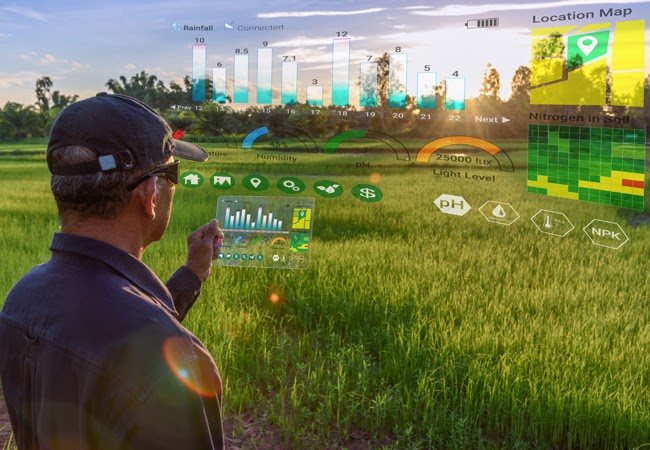The Importance of Data Aggregation in Precision Agriculture

Factors like urbanization, demographic changes, globalized trade, water scarcity, and climate change have created unique challenges for the agriculture sector. Not to mention evolving trends in food popularity—seriously, who knew there would be an increased demand for products like oats or almonds for the production of milk?
Farming and advanced technology may not go together in the minds of most—after all, it’s one of the oldest professions. Tech-supported automation has improved processes in many industries. And it’s doing the same for businesses in agriculture, reframing those challenges mentioned earlier as opportunities for businesses to improve through adaptation.
Supported by the most contemporary Information Technology (IT), agri-businesses are using precision software to take a prescriptive and holistic approach to their farming methods. With highly interoperable, data-collecting hardware and data-aggregating software at the heart of precision agriculture practices, agribusinesses are optimizing crop yields while minimizing the use of resources.
The Critical Hardware Collecting Agri-Data
Through the integration of tools to collect important qualitative and quantitative data, precision agriculture technology is changing the way that agribusinesses approach land management. By looking at the big picture with big data, growers are empowered to make the critical decisions that allow them to enhance their overall crop yields.
As demand increases, weather becomes more unpredictable, and resource conservation becomes more and more pressing for agribusinesses, traditional methods of farming have become not only old-fashioned but completely obsolete. Just as you wouldn’t get yourself to work via horse and buggy, growers aren’t out in the fields with an ox-pulled plow.
Instead, an arsenal of data-collecting, process-enhancing technology is in the field—or the air if we’re talking satellite-enabled tech—helping growers meet agricultural expectations in the form of improved and increased yields.
Agricultural Drones
For good reason, the agriculture sector has become one of the main commercial markets utilizing drones or—if you want to get more technical—Unmanned Aerial Vehicle (UAV) technology. With so many practical uses of drones in agriculture, precision software can’t be classified as high-performing if it doesn’t include drone waypoint software and drone integration capabilities.
UAVs rapidly survey vast stretches of land, map properties, monitor crop health, and even spray crops with water, pesticides, or fertilizers. When it comes to larger-scale farming operations, drones are a highly practical way to gather various types of intelligence regarding a large area of land in a short amount of time.
Soil Sensors
Soil sensors are another technology, literally, in the field—or, in this case, in the soil—helping crop growers make informed agricultural decisions. These sophisticated tools possess the capacity to detect a range of biological metrics for detailed soil composition insights.
Precise details on the moisture, macro/micronutrient, and nitrogen content of soil can be gathered and sent to monitoring apps for better visibility of what’s happening in the field. And like most high-value technology, they work with a host of other data collecting tools so agribusiness can truly cater to the needs of their crops.
GIS and GPS
When you hear the acronym GPS, you might be thinking of the navigator on your phone that gets you to the nearest gas station or to the restaurant across town you’ve heard of, but never tried. While the same technology is utilized for agribusiness, it’s used in a completely different way—to monitor crop health in the present and future.
Utilizing Geographic Information System (GIS) tools and Global Positioning System (GPS) technology further precise monitoring and management of crops’ overall health and yields are possible. GIS tools work with online resources to create crop forecasts based on multispectral images. And GPS-enabled machinery is equipped to operate in low visibility or facilitate the distribution of resources to pre-selected field locations.
Yield Monitors
Used for measuring crop and grain yield per area, yield monitors are another tool upsetting archaic farming practices. Installed in combine harvesters, yield monitors calculate the crop or grain flow into the machinery.
Sensors collect data on the amount of produce entering the Rotary Grinding Machine while simultaneously creating spatial maps that indicate yield rates for different fields or areas within a field to influence future best practices for crop management. Areas that indicate lower yield can then be provided with more resources to improve the number of crops or grain produced.
Weather Monitoring
Farmers don’t have to turn on the news or check weather apps to gain insights on the forecast anymore. Advanced technology insights such as air temperature, humidity, UV intensity, rain rates, wind direction, and wind speed are gathered by in-field weather monitoring stations that collect all weather-related data. With insights on accurate weather conditions combined with sensor data, only the optimal amount of resources is then used on crops.
Making Sense of the Data
While the aforementioned technologies can monitor the conditions of crops, on their own, they fail to do much more than just relay data. This is why a larger software system for these incredible remote monitoring tools to report to is needed.
After gathering massive amounts of data regarding conditions in the field, in-field tech transmits the data to an integrated Agriculture Monitoring System to create collaborative and comprehensive plans for yield management.
These systems offer a greater range of visibility for farmers when it comes to the present and future conditions of their fields through combined efforts such as sensor soil mapping, GIS imaging, and UAV near-infrared (NIR) multi-spectral sensor and radiometric thermal camera analysis.
And with better insights comes better game plans. Imagine a farming operation with multiple fields filled with different crops. Let’s say a particular crop is in soil with a lower nitrogen content and moisture content than is ideal for that particular plant’s needs. Soil sensors will indicate that these issues need to be addressed. But weather monitoring stations indicate that it’s going to rain.
The agribusiness could have ended up wasting one of our most valuable resources: water, while also over-saturating the crops, had they not utilized different data sources in conjunction. The right amount of fertilizer can then be administered without unnecessary water expenditure.
Connecting the Systems
All of the disparate sources of data agribusinesses use, though they can communicate with each other, won’t do so automatically. Systems need to talk to each other, and that means they have to be programmed to do so. Forging cross-channel communication between all the data-producing software behind the precision agriculture hardware is essential for making the most of said data.
With agriculture monitoring system dashboards that are accessible from the larger precision agriculture monitoring system, farmers gain a far greater understanding of the data provided by the sensors deployed in their fields (or barns, or greenhouses). Much more useful than separate reports, the exchange of metrics automatically reflects on comprehensive dashboards that can indicate operations issues that would otherwise go unnoticed—until it’s too late, of course.
The aggregation of relevant farm-related data also enables the system to produce predictive analytics that leads to informed decision-making and agricultural acumen. For example, soil information gathered over time can allow farmers to make better management decisions for the next planting and harvest cycles based on what the system determines. Equally, as important, environmental regulations are more easily followed through the precise monitoring these systems provide.
To take advantage of all the tech and data influencing precision agriculture, seamless integration is imperative. Once systems are interoperable, they produce and make use of site-specific agricultural data, so that agribusinesses can use the digital insights to achieve worthwhile returns on investment and significantly improved crop yields.





